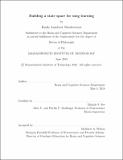| dc.contributor.advisor | Michale S. Fee. | en_US |
| dc.contributor.author | Mackevicius, Emily Lambert | en_US |
| dc.contributor.other | Massachusetts Institute of Technology. Department of Brain and Cognitive Sciences. | en_US |
| dc.date.accessioned | 2019-03-11T19:04:07Z | |
| dc.date.available | 2019-03-11T19:04:07Z | |
| dc.date.copyright | 2018 | en_US |
| dc.date.issued | 2018 | en_US |
| dc.identifier.uri | http://hdl.handle.net/1721.1/120871 | |
| dc.description | Thesis: Ph. D., Massachusetts Institute of Technology, Department of Brain and Cognitive Sciences, 2018. | en_US |
| dc.description | This electronic version was submitted by the student author. The certified thesis is available in the Institute Archives and Special Collections. | en_US |
| dc.description | Cataloged from student-submitted PDF version of thesis. | en_US |
| dc.description | Includes bibliographical references (pages 159-177). | en_US |
| dc.description.abstract | Song learning circuitry is thought to operate using a unique representation of each moment within each song syllable. Distinct timestamps for each moment in the song have been observed in the premotor cortical nucleus HVC, where neurons burst in sparse sequences. However, such sparse sequences are not present in very young birds, which sing highly variable syllables of random lengths. Furthermore, young birds learn by imitating a tutor song, and it was previously unclear precisely how the experience of hearing a tutor might shape auditory, motor, and evaluation pathways in the songbird brain. My thesis presents a framework for how these pathways may assemble during early learning, using simple neural mechanisms. I start with a neural network model for how premotor sequences may grow and split. This model predicts that the sequence-generating nucleus HVC would receive rhythmically patterned training inputs. I found such a signal when I recorded neurons that project to HVC. When juvenile birds sing, these neurons burst at the beginning of each syllable, and when the birds listen to a tutor, neurons burst at the rhythm of the tutor's song. Bursts marking the beginning of every tutor syllable could seed chains of sequential activity in HVC that could be used to generate the bird's own song imitation. I next used functional calcium imaging to characterize HVC sequences before and after tutor exposure. Analysis of these datasets led us to develop a new method for unsupervised detection of neural sequences. Using this method, I was able to observe neural sequences even prior to tutor exposure. Some of these sequences could be tracked as new syllables emerged after tutor exposure, and some sequences appeared to become coupled to the new syllables. In light of my new data, I expand on previous models of song learning to form a detailed hypothesis for how simple neural processes may perform song learning from start to finish. | en_US |
| dc.description.statementofresponsibility | by Emily Lambert Mackevicius. | en_US |
| dc.format.extent | 177 pages | en_US |
| dc.language.iso | eng | en_US |
| dc.publisher | Massachusetts Institute of Technology | en_US |
| dc.rights | MIT theses are protected by copyright. They may be viewed, downloaded, or printed from this source but further reproduction or distribution in any format is prohibited without written permission. | en_US |
| dc.rights.uri | http://dspace.mit.edu/handle/1721.1/7582 | en_US |
| dc.subject | Brain and Cognitive Sciences. | en_US |
| dc.title | Building a state space for song learning | en_US |
| dc.type | Thesis | en_US |
| dc.description.degree | Ph. D. | en_US |
| dc.contributor.department | Massachusetts Institute of Technology. Department of Brain and Cognitive Sciences | |
| dc.identifier.oclc | 1088724077 | en_US |
